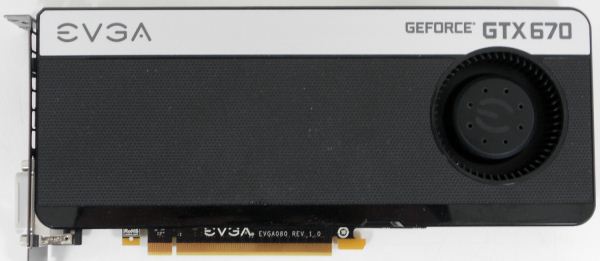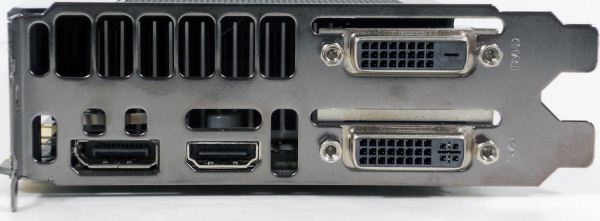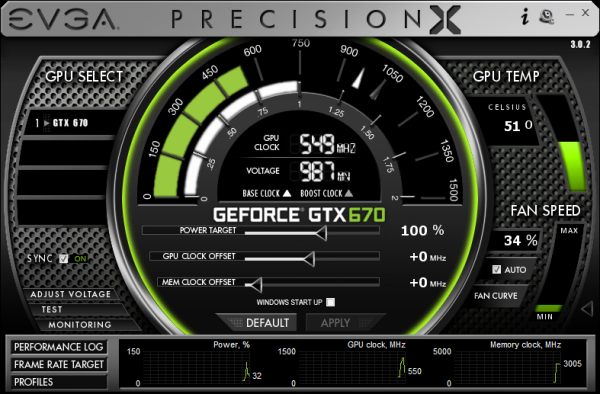NVIDIA GeForce GTX 670 Review Feat. EVGA: Bringing GK104 Down To $400
by Ryan Smith on May 10, 2012 9:00 AM ESTMeet The EVGA GeForce GTX 670 Superclocked
Our second card of the day is EVGA’s GeForce GTX 670 Superclocked, which in EVGA’s hierarchy is their first tier of factory overclocked cards. EVGA is binning GTX 670s and in turn promoting some of them to this tier, which means the GTX 670 Superclocked are equipped with generally better performing chips than the average reference card.
| GeForce GTX 670 Partner Card Specification Comparison | ||||
| EVGA GeForce GTX 670 Superclocked | GeForce GTX 670 (Ref) | |||
| CUDA Cores | 1344 | 1344 | ||
| Texture Units | 112 | 112 | ||
| ROPs | 32 | 32 | ||
| Base Clock | 967MHz | 915MHz | ||
| Boost Clock | 1046MHz | 980MHz | ||
| Memory Clock | 6210MHz | 6008MHz | ||
| Memory Bus Width | 256-bit | 256-bit | ||
| Frame Buffer | 2GB | 2GB | ||
| TDP | 170W | 170W | ||
| Manufacturing Process | TSMC 28nm | TSMC 28nm | ||
| Width | Double Slot | Double Slot | ||
| Length | 9.5" | 9.5" | ||
| Warranty | 3 Years | N/A | ||
| Price Point | $419 | $399 | ||
For the GTX 670 SC, EVGA has given both the core clock and memory clock a moderate boost. The core clock has been increased by 52MHz (6%) to 967MHz base and 66MHz (7%) boost to 1046MHz. Meanwhile the memory clock has been increased by 202MHz (3%) to 6210MHz.
Other than the clockspeed changes, the GTX 670 SC is an almost-reference card utilizing a reference PCB with a slightly modified cooler. EVGA is fabricating their own shroud, but they’ve copied NVIDIA’s reference shroud down to almost the last detail. The only functional difference is that the diameter of the fan intake is about 5mm less, otherwise the only difference is that EVGA has detailed it differently than NVIDIA and used some rounded corners in place of square corners.
The only other change you’ll notice is that EVGA is using their own high flow bracket in place of NVIDIA’s bracket. The high flow bracket cuts away as much metal as possible, maximizing the area of the vents. Though based on our power and temperature readings, this doesn’t seem to have notably impacted the GTX 670 SC.
While we’re on the matter of customized cards and factory overclocks, it’s worth reiterating NVIDIA’s position on factory overclocked cards. Reference and semi-custom cards (that is, cards using the reference PCB) must adhere to NVIDIA’s power target limits. For GTX 670 this is a 141W power target, with a maximum power target of 122% (170W). Fully custom cards with better power delivery circuitry can go higher, but not semi-custom cards. As a result the flexibility in building semi-custom cards comes down to binning. EVGA can bin better chips and use them in cards such as the Superclocked – such as our sample which can go 17 boost bins over the base clock versus 13 bins for our reference GTX 670 – but at the end of the day for stock performance they’re at the mercy of what can be accomplished within 141W/170W.
In any case, as the card is otherwise a reference GTX 670 EVGA is relying on the combination of their factory overclock, their toolset, and their strong reputation for support to carry the card. EVGA has priced the card at $419, $20 over the GTX 670 MSRP, in-line with other factory overclocked cards.
On the subject of pricing and warranties, since this is the first EVGA card we’ve reviewed since April 1st, this is a good time to go over the recent warranty changes EVGA has made.
Starting April 1st, EVGA has implemented what they’re calling their new Global Warranty Policy. Starting July 1st, 2011 (the policy is being backdated), all new EVGA cards ship with at least a 3 year warranty. And for the GTX 600 series specifically, so far EVGA has only offered models with a 3 year warranty in North America, which simplifies their product lineup.
To complement the 3 year warranty and replace the lack of longer term warranties, EVGA is now directly selling 2 and 7 year warranty extensions, for a total of 5 and 10 years respectively. So instead of buying a card with a 3 year warranty or a longer warranty, you’ll simply buy the 3 year card and then buy a warranty extension to go with it. However the extended warranty requires that the card be registered and the warranty purchased within 30 days.
The second change is that the base 3 year warranty no longer requires product registration. EVGA has other ways to entice buyers into registering, but they’ll now honor all applicable cards for 3 years regardless of the registration status. At the same time the base 3 year warranty is now a per-product warranty (e.g. a transferable warranty) rather than per-user warranty, so the base warranty will transfer to 2nd hand buyers. The extended warranties however will not.
The third change is how EVGA is actually going to handle the warranty process. First and foremost, EVGA is now allowing cards to be sent to the nearest EVGA RMA office rather than the office for the region the card was purchased from. For example a buyer moving from Europe to North America can send the card to EVGA’s North American offices rather than sending it overseas.
Finally, EVGA is now doing free cross shipping, alongside their existing Advanced RMA program. EVGA will now cross-ship replacement cards for free to buyers. The buyer meanwhile is responsible for paying to ship the faulty card back and putting up collateral on the new card until EVGA receives the old card.
There’s also one quick change to the step-up program that will impact some customers. With the move to purchasing extended warranties, the step-up program is only available to customers who either purchase an extended warranty or purchase an older generation card that comes with a lifetime warranty. Step-up is not available to cards with only the base 3 year warranty.
Moving on, along with EVGA’s new warranty EVGA is bundling the latest version of their GPU utilities, Precision X and OC Scanner X.
Precision X, as we touched upon quickly in our GTX 680 review, is the latest iteration of EVGA’s Precision overclocking & monitoring utility. It’s still based on RivaTuner and along with adding support for the GTX 600 series features (power targets, framerate caps, etc), it also introduces a new UI. Functionality wise it’s still at the top of the pack along with the similarly RivaTuner powered MSI Afterburner. Personally I’m not a fan of the new UI – circular UIs and sliders aren’t particularly easy to read – but it gets the job done.
OC Scanner X has also received a facelift and functionality upgrade of its own. Along with its basic FurMark-ish stress testing and error checking, it now also offers a basic CPU stress test and GPU benchmark.



















414 Comments
View All Comments
eachus - Friday, May 11, 2012 - link
"I would like to see a 7970OC comparison? I was trying to find a 680 but gave up and got an 7970oc for $499 it's running at 1025Mhz and should be faster than a 680."No need really--unless you want to use the latest and greatest benchmarks in an on-line pissing contest. Let's face it. ANY high-end card, including now what AMD calls mid-range (the 7800 series) will run a 1920x1200 display with no trouble. Upgrade to three displays (5760x1200) or one 2560x1600 display, and now the high-end cards make sense. But keep track of the evolving drivers...the original 7970 benchmarks are now dead letters given the 12.4 drivers. Fixing lots of little gotchas in the drivers means that now you don't need two cards to drive a three screen display. This is true of both nVidia and AMD. (Compare the benchmarks here with the launch benchmarks for the 680. The 7970 wins several benchmarks now, which will last until nVidia has some non-launch drivers. Since you are getting more performance than you originally paid for, just sit back and enjoy it.)
Oh, and one other point which is starting to become an issue: 3d graphics. When I find a 3d display that doesn't give me headaches with a few hours use, I'll buy one. Right now though, it is already clear that 120 fps displays will be needed for that, and AMD has been considering 90+ fps out of the ROPs as sufficient--at least with 2560x1600, non-Crossfire. :-(
CeriseCogburn - Friday, May 11, 2012 - link
Well eachus amd fanboy friend, instead of calling him and idiot owner of the 7970 in a useless pissing contest, why don't you just tell him the truth ?The 7970 LOSES @ 1,025 core clock to the stock 680.
+
And yes, amd sucks when it comes to 3d gaming, while nVidia is the king and has the market absolutely cornered.
CeriseCogburn - Friday, May 11, 2012 - link
Here's a comparison dunce.http://hexus.net/tech/reviews/graphics/37209-gefor...
The amd card loses with just it overclocked.
Enjoy that amd fail.
Chris Simmo - Thursday, May 10, 2012 - link
Excellent review. Excellent card! One thing I didn't see was image quality. Both in game and video/HT capability. I know its not a common thing amoungst gamers and self builders, but we do complete systems and always found that AMD does a better job with video than NVIDIA. Most noticable are old TV show rips or youtube videos. Do you have any opinion? Just want to know if its a good allrounder or only good at games.CeriseCogburn - Friday, May 11, 2012 - link
Well, you must have enjoyed the years long amd youtube issues with constantly crashing adobe flash, having to turn off the HW acell, etc.I sure hope your customers didn't mind.
Chris Simmo - Friday, May 11, 2012 - link
Actually we have had few reports, and they have been pretty even on both sides, but the only time I have had to turn off hardware acceleration is with TMT5 SIMHD engine with any HD7000 card, and I have seen the flash problems you are talking about, but strangly only on notebooks, not desktops. I do believe a fix is in the works for TMT though. I really hope so. Anyway, I am not looking at it from a fanboy point of view. I will give my customers what they want, but will push the most capable product for their application and for a long while now this has generally been AMD graphics with Intel CPU's. This has come up well as we have had an incredibly low failure rate.Support is important and in the last 6 months I have worked with both ASUS and AMD support to correct issues in motherboards and driver bugs, and as long as they get fixed I am happy, providing it’s not a really big issue to start with.
I’m sure you have worked with 1200 graphics cards in the last 4 years and know exactly what you are talking about, and offer support to match the warranty, which in our case is 2 years.
I am excited about the 600 series though, and will look to stock the GTX670 when the prices settle.
CeriseCogburn - Saturday, May 12, 2012 - link
Hundreds of graphics cards but not 1200 graphics cards, so yes I do know what I'm talking about, and I'm not stuck in a corporate environment where information and standard responses are a required line to be towed, so it's likely my experience this past year is actually far wider than yours.In any case, you allude to "pretty even on both sides" with flash player problems, but before you claimed youtube was great with amd, or at least claimed some sort of superior image quality - and mentioned old movie clips, but by your own comparison you must be servicing nVidia cards as well, or perhaps you are not, and the choice was made and now...
So to me that appears to be your corporate environment talking as you'll go with whatever your masters say is happening, and it is said to be better then, by default necessity - as whomever decides in the power structure will in effect be demanding employees tow that line, it is after all, foolish to do otherwise, especially in a forum where you could be easily discovered doing so.
I frankly find your surprise lack of knowledge with flash player issues disturbing, but attribute it to the call center corporate support model.
Anyway go ahead with your issue, and find the answer you need. I think you should do well with whatever it is you need for answer, and think no doubt that has already been determined.
Chris Simmo - Sunday, May 13, 2012 - link
You assume a lot. There isn't much of your argument there that actually holds any truth, and you are the foolish one to assume otherwise. To me it appears you are just looking for a fight. No better than a common troll. And as a result I won't bother with a rebuttal or correcting any of your assumptions.Ryan Smith - Friday, May 11, 2012 - link
Hi Chris;Since image quality is almost entirely a function of architectural improvements as opposed to the individual SKUs, we don't do a major IQ writeup for every card. For Kepler in game image quality hasn't changed (NVIDIA hasn't changed any of the fundamental algorithms). As for HT/video, we're hoping to have something up soon once we can secure a more HTPC-suitable GK107 card.
-Thanks
Ryan Smith
Chris Simmo - Friday, May 11, 2012 - link
Thanks Ryan. Yeah, I knew its an architectural thing. I build some very high powered HTPC as gaming systems and since this card will no doubt end up shipping with smaller coolers, it seems like a great card to put in a gaming HTPC. Looking forward to the HTPC review though.